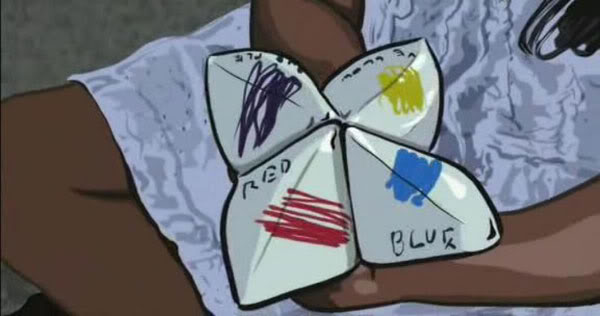Week 7 Topic: “Fortune Teller &&|| One Button”
To play: click in side the yellow area and press space to advance
This feels like one of the most finished prototypes I’ve made so far for game a week. It was made using p5.js and it was kind of more work to make than it felt like it should have been. There’s a lot of timers in the code used to cycle between images and pause between game states. Maybe the most ‘clever’ thing in it was matching chars from a string to same named sound files so that the sketch could play sounds for each letter in the name of a selected color-
// Load sounds for each letter in the color names
"bdeglnoruwy".split('').forEach(letter => {
letterSounds[letter] = loadSound(`/sounds/${letter}.wav`);
});I’m interested in what the students come up with for this one. There’s a lot of ways that a fortune teller can feel like a spreadsheet and a random number generator, so we’re looking at ways these games make the player feel like they’re involved. Here’s the assignment text I posted (where I gave a shout out to Rachel Weil, who has made several excellent Fortune Telling games).
What’s a fortune teller game? What kind of game was this little folded paper object? What was fun about playing with it?
Fortune tellers are their own whole genre of game that we usually classify as games of chance, with the hope that randomness has something to tell us about ourselves and our future. There’s lots of ancient fortune telling games that we could draw on, like Geomancy.
Austin game artist and former SDCT lecturer Rachel Weil has been making modern fortune teller games for anachronistic devices, like the original Nintendo Entertainment System.There’s also a rich tradition of toys and carnival attractions that tell fortunes, like “love testers” and penny arcade fortune tellers.
Many of these existing fortune teller precedents could fit well with a single button game. Some existing single-button games that have found popularity are endless runners like Adam Saltsman’s Cannabalt. The challenge with a single button game is to keep the player engaged. Timing is usually the deciding factor in these games if skill is involved. Whether you are making a fortune telling game, a one-button game or combining both themes, what we don’t want to see is a game that always plays the same- one that just waits for the player to press a button and move through a pre-determined experience. We want to sense that we are interacting with something deeper- who wants a predictable fortune?
Related: Downpour Divinators
